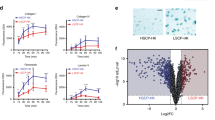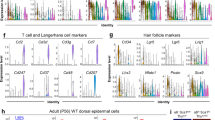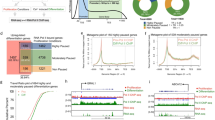Abstract
The epidermis is a highly organized structure, the integrity of which is central to the protection of an organism1. Development and subsequent maintenance of this tissue depends critically on the intricate balance between proliferation and differentiation of a resident stem cell population1,2; however, the signals controlling the proliferation-differentiation switch in vivo remain elusive3. Here, we show that mice carrying a homozygous missense mutation in interferon regulatory factor 6 (Irf6), the homolog of the gene mutated in the human congenital disorders Van der Woude syndrome and popliteal pterygium syndrome, have a hyperproliferative epidermis that fails to undergo terminal differentiation, resulting in soft tissue fusions. We further demonstrate that mice that are compound heterozygotes for mutations in Irf6 and the gene encoding the cell cycle regulator protein stratifin (Sfn; also known as 14-3-3σ) show similar defects of keratinizing epithelia. Our results indicate that Irf6 is a key determinant of the keratinocyte proliferation-differentiation switch and that Irf6 and Sfn interact genetically in this process.
This is a preview of subscription content, access via your institution
Access options
Subscribe to this journal
Receive 12 print issues and online access
$209.00 per year
only $17.42 per issue
Buy this article
- Purchase on Springer Link
- Instant access to full article PDF
Prices may be subject to local taxes which are calculated during checkout






Similar content being viewed by others
References
Fuchs, E. & Raghavan, S. Getting under the skin of epidermal morphogenesis. Nat. Rev. Genet. 3, 199–209 (2002).
Watt, F.M. Stem cell fate and patterning in mammalian epidermis. Curr. Opin. Genet. Dev. 11, 410–417 (2001).
Dotto, G.P. Signal transduction pathways controlling the switch between keratinocyte growth and differentiation. Crit. Rev. Oral Biol. Med. 10, 442–457 (1999).
Taniguchi, T., Ogasawara, K., Takaoka, A. & Tanaka, N. IRF family of transcription factors as regulators of host defense. Annu. Rev. Immunol. 19, 623–655 (2001).
Kondo, S. et al. Mutations in IRF6 cause Van der Woude and popliteal pterygium syndromes. Nat. Genet. 32, 285–289 (2002).
Escalante, C.R., Yie, J., Thanos, D. & Aggarwal, A.K. Structure of IRF-1 with bound DNA reveals determinants of interferon regulation. Nature 391, 103–106 (1998).
Hardman, M.J., Sisi, P., Banbury, D.N. & Byrne, C. Patterned acquisition of skin barrier function during development. Development 125, 1541–1552 (1998).
Benitah, S.A., Frye, M., Glogauer, M. & Watt, F.M. Stem cell depletion through epidermal deletion of Rac1. Science 309, 933–935 (2005).
Guenet, J.L., Salzgeber, B. & Tassin, M.T. Repeated epilation: a genetic epidermal syndrome in mice. J. Hered. 70, 90–94 (1979).
Herron, B.J. et al. A mutation in stratifin is responsible for the repeated epilation (Er) phenotype in mice. Nat. Genet. 37, 1210–1212 (2005).
Li, Q., Lu, Q., Estepa, G. & Verma, I.M. Identification of 14–3-3sigma mutation causing cutaneous abnormality in repeated-epilation mutant mouse. Proc. Natl. Acad. Sci. USA 102, 15977–15982 (2005).
Takeda, K. et al. Limb and skin abnormalities in mice lacking IKKalpha. Science 284, 313–316 (1999).
Hu, Y. et al. Abnormal morphogenesis but intact IKK activation in mice lacking the IKKalpha subunit of IkappaB kinase. Science 284, 316–320 (1999).
Li, Q. et al. IKK1-deficient mice exhibit abnormal development of skin and skeleton. Genes Dev. 13, 1322–1328 (1999).
Pellegrini, G. et al. p63 identifies keratinocyte stem cells. Proc. Natl. Acad. Sci. USA 98, 3156–3161 (2001).
Hermeking, H. et al. 14–3-3 sigma is a p53-regulated inhibitor of G2/M progression. Mol. Cell 1, 3–11 (1997).
Chan, T.A., Hermeking, H., Lengauer, C., Kinzler, K.W. & Vogelstein, B. 14–3-3sigma is required to prevent mitotic catastrophe after DNA damage. Nature 401, 616–620 (1999).
Lees, M.M., Winter, R.M., Malcolm, S., Saal, H.M. & Chitty, L. Popliteal pterygium syndrome: a clinical study of three families and report of linkage to the Van der Woude syndrome locus on 1q32. J. Med. Genet. 36, 888–892 (1999).
Dixon, J. et al. Tcof1/Treacle is required for neural crest stem cell formation and proliferation through its role in mature ribosome production, deficiencies in which cause craniofacial abnormalities. Proc. Natl. Acad. Sci. USA 103, 13403–13408 (2006).
Ghassibe, M. et al. Six families with Van der Woude and/or popliteal pterygium syndrome: all with a mutation in the IRF6 gene. J. Med. Genet. 41, e15 (2004).
Ingraham, C.R. et al. Abnormal skin, limb and craniofacial morphogenesis in mice deficient for interferon regulatory factor 6 (Irf6). Nat. Genet. advance online publication 15 October 2006 (doi:10.1038/ng1903).
Mills, A.A. et al. p63 is a p53 homologue required for limb and epidermal morphogenesis. Nature 398, 708–713 (1999).
Yang, A. et al. p63 is essential for regenerative proliferation in limb, craniofacial and epithelial development. Nature 398, 714–718 (1999).
Koster, M.I., Kim, S., Mills, A.A., DeMayo, F.J. & Roop, D.R. p63 is the molecular switch for initiation of an epithelial stratification program. Genes Dev. 18, 126–131 (2004).
Sil, A.K., Maeda, S., Sano, Y., Roop, D.R. & Karin, M. IκB Kinase-α acts in the epidermis to control skeletal and craniofacial morphogenesis. Nature 428, 660–664 (2004).
Wallin, J. et al. The role of Pax-1 in axial skeleton development. Development 120, 1109–1121 (1994).
Mooney, L.M. & Whitmarsh, A.J. Docking interactions in the c-Jun N-terminal pathway. J. Biol. Chem. 279, 11843–11852 (2004).
Inman, C.K., Li, N. & Shore, P. Oct-1 counteracts autoinhibition of Runx2 DNA binding to form a novel Runx2/Oct-1 complex on the promoter of the mammary gland-specific gene β-casein. Mol. Cell. Biol. 25, 3182–3193 (2005).
Acknowledgements
We thank J. Murray and B. Schutte (University of Iowa) for providing the antibody to IRF6 and data in advance of publication. We also thank H. Worthington for statistical analysis, D. Clayton for his help with the imaging and the Electron Microscope Facility in the Faculty of Life Sciences, University of Manchester, particularly A. Mironov, for their assistance. This study was supported by grants from the US National Institutes of Health (P50-DE016215) and the Wellcome Trust (064732, 066173).
Author information
Authors and Affiliations
Contributions
R.J.R. generated and analyzed the mutant mice and wrote the paper, J.D. designed experiments and wrote the paper, S.M. and P.S. performed the electrophoretic mobility shift assays, M.J.H. designed experiments, L.K. performed the blastocyst injections, R.P.B.-H. designed experiments, A.W. performed the co-immunoprecipitation experiments and M.J.D. designed experiments and wrote the paper.
Corresponding author
Ethics declarations
Competing interests
The authors declare no competing financial interests.
Supplementary information
Supplementary Fig. 1
Gene targeting of the Irf6 locus. (PDF 98 kb)
Supplementary Table 1
Sequences of primers used in the analysis of IRF6. (PDF 69 kb)
Rights and permissions
About this article
Cite this article
Richardson, R., Dixon, J., Malhotra, S. et al. Irf6 is a key determinant of the keratinocyte proliferation-differentiation switch. Nat Genet 38, 1329–1334 (2006). https://doi.org/10.1038/ng1894
Received:
Accepted:
Published:
Issue Date:
DOI: https://doi.org/10.1038/ng1894
This article is cited by
-
The urothelial gene regulatory network: understanding biology to improve bladder cancer management
Oncogene (2024)
-
Functions of the RIP kinase family members in the skin
Cellular and Molecular Life Sciences (2023)
-
Negative regulation of interferon regulatory factor 6 (IRF6) in interferon and NF-κB signalling pathways of common carp (Cyprinus carpio L.)
BMC Veterinary Research (2022)
-
TBX1 targets the miR-200–ZEB2 axis to induce epithelial differentiation and inhibit stem cell properties
Scientific Reports (2022)
-
Cyproheptadine, an epigenetic modifier, exhibits anti-tumor activity by reversing the epigenetic silencing of IRF6 in urothelial carcinoma
Cancer Cell International (2021)



